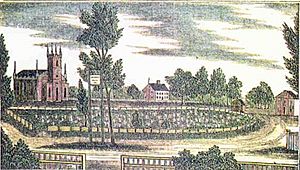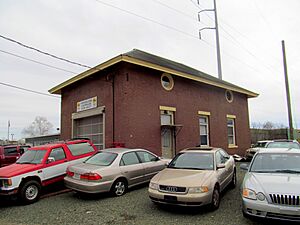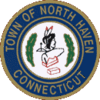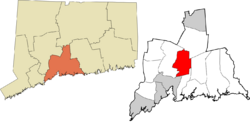North Haven, Connecticut facts for kids
Quick facts for kids
North Haven, Connecticut
|
|||
|---|---|---|---|
| Town of North Haven | |||

St. John's Episcopal Church, built in 1834
|
|||
|
|||
 New Haven County and Connecticut New Haven County and Connecticut |
|||
| Country | |||
| U.S. state | |||
| County | New Haven | ||
| Region | South Central CT | ||
| Incorporated | 1786 | ||
| Government | |||
| • Type | Selectman-town meeting | ||
| Area | |||
| • Total | 21.1 sq mi (54.6 km2) | ||
| • Land | 20.8 sq mi (53.8 km2) | ||
| • Water | 0.3 sq mi (0.8 km2) | ||
| Elevation | 66 ft (20 m) | ||
| Population
(2020)
|
|||
| • Total | 24,253 | ||
| • Density | 1,149.4/sq mi (444.2/km2) | ||
| Time zone | UTC−5 (Eastern) | ||
| • Summer (DST) | UTC−4 (Eastern) | ||
| ZIP Code |
06473
|
||
| Area code(s) | 203/475 | ||
| FIPS code | 09-54870 | ||
| GNIS feature ID | 0213479 | ||
| Major highways | |||
North Haven is a town in New Haven County, Connecticut, United States. It is located just outside the city of New Haven. The town is part of the South Central Connecticut Planning Region. In 2020, about 24,253 people lived there.
North Haven is home to several important schools of Quinnipiac University. These include the School of Health Sciences, Nursing, Law, Education, and Medicine. The town has easy access to major highways like Interstate 91 and the Wilbur Cross Parkway (Route 15). It is also close to Sleeping Giant State Park and Yale University.
Contents
History of North Haven


Early Days and Founding
In 1714, Reverend James Pierpont of New Haven gave 8 acres of land to his neighbors. This land was in the Northeast Parish, which is now North Haven. He wanted them to build a meeting house, a place for training, and a cemetery there.
The first meeting house was finished in 1722. It stood on the Green, which is still a central part of North Haven today.
In the early 1700s, about 40 families lived in North Haven. Most of these people were farmers. They grew and made most of what they needed for their families. In 1786, North Haven officially became its own town, separate from New Haven. New roads were built to help people travel and communicate. These included the Hartford Turnpike in 1798 and the Middletown Turnpike in 1813.
Growth and Industry
The first United States census in 1790 counted 1,236 people in North Haven. It was mostly a farming community. Interestingly, in 1789, there were more sheep (1,620) than people in North Haven!
By the mid-1800s, the Industrial Revolution began to change the town. In 1838, the New Haven and Hartford Railroad built train tracks near the Quinnipiac River. Small factories also started, like one making farm tools in Clintonville in 1830. In 1850, most people (62%) were still farmers. But about one-third worked in other jobs, like mechanics, brickmakers, and shoemakers.
After the Civil War, brick production grew a lot, especially by the I.L. Stiles Co. This brought many immigrants to North Haven from Ireland, Germany, Italy, and Poland. By 1880, 11 out of every 100 people in town were born outside the United States.
In the 1880s, Solomon Linsley, an architect from North Haven, built the Memorial Town Hall. He also built the new District 4 School. Linsley designed and built 32 Victorian style houses and public buildings in North Haven.
Modern Transportation and Population Boom
By 1900, public transportation was very important. Eighteen passenger trains stopped at the Broadway station every day. Trolleys also ran from Montowese to New Haven. Later, the trolley line was extended north to Wallingford.
After World War I, cars changed life in North Haven. The brickyards along the river were still a major industry. But people who owned cars could live in North Haven and drive to New Haven for work. Small housing developments began to appear in the southern part of town.
North Haven grew very quickly after World War II. Its population quadrupled (became four times larger) between 1945 and 1970. Two large factories, Pratt & Whitney and Marlin Firearms, helped this growth. To support the growing community, new buildings were needed. A new police station, firehouse, library, and five schools were built in the 1950s and 1960s. The town continues to grow and expand even today.
Even with its fast growth, North Haven still uses a town meeting style of government. This means citizens can directly participate in local decisions.
Geography of North Haven
North Haven covers about 21.1 square miles (54.6 km2). Most of this is land (20.8 square miles or 53.8 km2), and a small part is water (0.3 square miles or 0.8 km2). The town is less than 10 miles (16 km) from Long Island Sound.
North Haven is located about 27 miles (43 km) south of Hartford. It is also 76 miles (122 km) northeast of New York City. The center of town is along U.S. Route 5.
North Haven shares its borders with the city of New Haven. It also borders the towns of East Haven, Hamden, North Branford, and Wallingford.
Main Areas of North Haven
North Haven has several important communities or neighborhoods:
- North Haven Center
- Clintonville
- Montowese
- Green Acres
- Ridge Road
Economy and Jobs
North Haven has a growing business and manufacturing sector. About 12,640 people work in the town. There are more than 75 manufacturing and commercial companies in North Haven. Many of these are large businesses.
The town has five industrial parks, covering about 490 acres (2.0 km2). Companies like Connecticut Container Corp. and O.F. Mossberg & Sons are located here. In 2019, Amazon opened a huge fulfillment center in North Haven. This center is 855,000 square feet and created over 1,500 jobs. It can ship over 1,000,000 items every day.
Education is also a big part of North Haven's economy. Quinnipiac University has several graduate schools here. A branch of Gateway Community College and The University of Connecticut New Haven County Extension Center are also in town. Because it's close to Yale University, many university staff and faculty choose to live in North Haven.
Top Employers in North Haven
Here are some of the biggest employers in North Haven, based on a 2022 report:
| # | Employer | # of Employees |
|---|---|---|
| 1 | Amazon | 5,500 |
| 2 | Medtronic | 1,834 |
| 3 | Town of North Haven | 823 |
| 4 | Quinnipiac University | 437 |
| 5 | ACES - Area Cooperative Educational Services | 392 |
| 6 | Brescome Barton | 350 |
| 7 | O.F. Mossberg & Sons Inc. | 207 |
| 8 | XPO Logistics | 178 |
| 9 | Cowles Inc | 175 |
| 10 | HB Communications Inc | 175 |
Education in North Haven
North Haven has a public school system with several schools for different age groups.
Elementary Schools
There are four public elementary schools in North Haven:
- Clintonville
- Green Acres
- Montowese
- Ridge Road
Middle and High Schools
The town also has one public middle school and one public high school:
- North Haven Middle School
- North Haven High School
Higher Education
Quinnipiac University has a large graduate campus in North Haven. This campus is 104 acres (0.42 km2) and was bought in 2007. It is home to the Frank H. Netter M.D. School of Medicine at Quinnipiac University. It also houses the Schools of Health Sciences, Nursing, Law, and Education.
The University of Connecticut New Haven County Extension Center is also located in North Haven.
Notable People from North Haven
Many interesting people have connections to North Haven:
- Michael Barbaro – A journalist and host of The New York Times podcast, The Daily.
- Charles H. Eglee – A writer and producer for television and movies.
- Kevin Gilbride – A former offensive coordinator for the New York Giants football team.
- Donald Kagan – A historian and classicist who taught at Yale University.
- Paul Marcarelli – An actor and screenwriter.
- John M. Merriman – A Yale professor, French historian, and writer.
- Tim O'Brien – A famous illustrator and President of the Society of Illustrators.
- Barbara Ostfeld – The first woman to become a cantor (a leader of prayer and song) in Reform Judaism.
- John Aristotle Phillips – An entrepreneur.
- Ezra Stiles – A former president of Yale University.
- Tiffany Weimer – An American professional soccer player.
Places to Visit in North Haven
- Peter's Rock
- Quinnipiac River State Park
- Wharton Brook State Park
Images for kids
See also
 In Spanish: North Haven (Connecticut) para niños
In Spanish: North Haven (Connecticut) para niños





